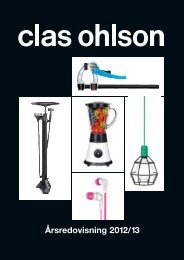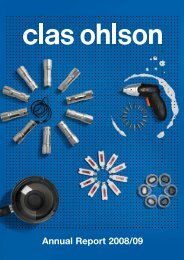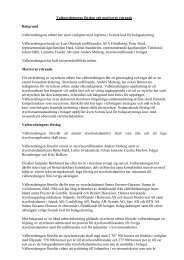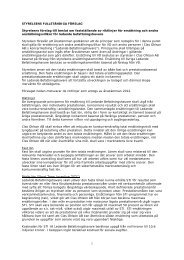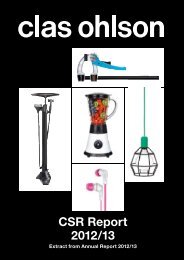Annual Report 2012/13 - Clas Ohlson
Annual Report 2012/13 - Clas Ohlson
Annual Report 2012/13 - Clas Ohlson
You also want an ePaper? Increase the reach of your titles
YUMPU automatically turns print PDFs into web optimized ePapers that Google loves.
emuneration is also conditional upon the performance on which earnings<br />
are based being sustainable over time, and that <strong>Clas</strong> <strong>Ohlson</strong> AB is able to<br />
reclaim such remuneration that was paid due to information that later turned<br />
out to be obviously erroneous.<br />
Long Term Incentive ”LTI”<br />
The aim of long-term incentive programmes is to create the prerequisites for<br />
retaining and recruiting competent employees to the Group. The programmes<br />
were designed to encourage participants to become shareholders in<br />
the company, which is expected to have a positive impact on their long-term<br />
work performance. Connecting participants’ rewards to the company’s profit<br />
and value development will continue to promote company loyalty and thus<br />
sustainable value growth in the company.<br />
Long-term incentive programmes that entitle employees to acquire shares<br />
are subject to AGM approval. LTI 2010, LTI 2011 and LTI <strong>2012</strong> were in<br />
effect during the financial year. LTI 2010 was concluded after the close of the<br />
financial year and LTI 20<strong>13</strong> was launched. LTI 2010, LTI 2011, LTI <strong>2012</strong> and<br />
LTI 20<strong>13</strong> are share matching and profit-based employee stock option plans.<br />
Long-term incentive programmes LTI 2009, LTI 2010, LTI 2011 and<br />
LTI <strong>2012</strong><br />
LTI 2010, LTI 2011 and LTI <strong>2012</strong> were approved at the <strong>Annual</strong> General<br />
Meetings 2009, 2010 and 2011. The programmes encompass up to 45<br />
members of senior management and other individuals regarded as having a<br />
long-term impact on <strong>Clas</strong> <strong>Ohlson</strong>’s development.<br />
To participate in the plan, employees must acquire series B shares in <strong>Clas</strong><br />
<strong>Ohlson</strong> corresponding to a value of not less than 5 per cent and not more<br />
than 10 per cent of their annual basic salary. Participants acquired series<br />
B <strong>Clas</strong> <strong>Ohlson</strong> shares, at market price, which the company will later match<br />
(1:1) free of charge through allotment of shares. If the employee holds the<br />
acquired shares and is still employed by the Group three years after the date<br />
of acquisition, the company will issue matching shares to the employee.<br />
The employee may also be allotted profit-based employee stock options.<br />
Employee stock options are allocated free of charge and each stock option<br />
entitles the holder to acquire one series B <strong>Clas</strong> <strong>Ohlson</strong> share. When the option<br />
is exercised, the price per share is calculated at 110 per cent of the average<br />
of the volume-weighted average price paid for the series B <strong>Clas</strong> <strong>Ohlson</strong> share<br />
on the Nasdaq OMX Stockholm established for each day during a period<br />
of 10 trading days prior to the acquisition period. The exercise price for the<br />
LTI 2010, LTI 2011 and LTI <strong>2012</strong> has been set at SEK 141.30, SEK 108.10<br />
and SEK 109.10 per share. The options may be exercised not earlier than<br />
three years and not later than seven years from the date of allotment. For an<br />
option to be exercised, the holder must still be employed by the <strong>Clas</strong> <strong>Ohlson</strong><br />
Group and have retained his/her personal investment for three years from the<br />
date of allotment. The option holdings do not provide entitlement to receive<br />
dividends on the underlying shares.<br />
The number of employee stock options that may be exercised depends<br />
on the number of series B shares that the employee has acquired within the<br />
framework of the plan, and whether the company’s growth and profit growth<br />
during the first three financial years increase to the levels set by the Board.<br />
These established levels are: Entry, Target and Stretch, with a straight-line<br />
increase between each profit level.<br />
Entry is a minimum level that must be exceeded in order for an employee<br />
stock option to be exercised. The three levels correspond to the following<br />
number of employee stock options:<br />
Accordingly, the total number of employee stock options that may be exercised<br />
by each participant is limited to 15 per acquired series B share.<br />
The qualification and performance periods for the LTI 2010 were valid<br />
from 1 May 2010 until 30 April 20<strong>13</strong>. A total of 26,581 shares were allotted<br />
on 2 May, after the close of the financial year, in accordance with the AGM’s<br />
resolution regarding share matching of one share per share purchased to<br />
those participants who remained employed after the three-year qualification<br />
period. The set criteria pertaining to the average sales and profit growth per<br />
share for the period 2010 to 20<strong>13</strong> were not achieved, which resulted in no<br />
options being allotted to participants and the LTI 2010 was thus concluded.<br />
Participants of LTI 2009 were already entitled to exercise seven options per<br />
purchased share at an exercise price of SEK 98.10.<br />
It was not possible to exercise any of the options for LTI 2011 or LTI <strong>2012</strong><br />
on 30 April 20<strong>13</strong>. The number that may be exercised after three years is<br />
based on the achievement of growth and profit targets in accordance with<br />
the above. The sum that is expensed is based on the level of 0 options per<br />
share for LTI 2010, 5 options per share for LTI 2011 and 10 options per share<br />
for LTI <strong>2012</strong>.<br />
In accordance with the above, LTI 2011 and LTI <strong>2012</strong> will include the following<br />
number of series B shares and employee stock options for the various<br />
participant categories if the Target level is achieved (refer to the table below).<br />
The cost recognised in profit or loss for <strong>2012</strong>/<strong>13</strong> totalled SEK 0.2 M,<br />
including social security contributions.<br />
Share repurchase for LTI programmes<br />
During 2010, 2011 and <strong>2012</strong>, <strong>Clas</strong> <strong>Ohlson</strong> repurchased series B <strong>Clas</strong> <strong>Ohlson</strong><br />
shares to fulfil the company’s long-term obligations under the incentive<br />
programmes. The shares will be allotted or sold to participants.<br />
Pensions and other benefits<br />
As a main rule, pension agreements shall be defined-contribution and<br />
designed in accordance with the levels and practices that apply in the country<br />
in which the member of senior management is employed. Other benefits may<br />
occur in accordance with the conditions that apply in the country in which the<br />
member of senior management is employed. However, such benefits may<br />
not constitute a large portion of the total remuneration.<br />
Note 7<br />
Remuneration to auditors<br />
Group<br />
Parent Company<br />
<strong>2012</strong>/<strong>13</strong> 2011/12 <strong>2012</strong>/<strong>13</strong> 2011/12<br />
Öhrlings<br />
PricewaterhouseCoopers<br />
Remuneration for audit<br />
engagement 2.2 2.6 1.3 1.6<br />
Remuneration for other<br />
consultations 0.2 0.3 0.1 0.2<br />
Tax consultations 0.6 0.1 0.5 0.0<br />
Other 0.2 0.1 0.1 0.1<br />
Total 3.2 3.1 2.0 1.9<br />
• Entry: five options per acquired series B share<br />
• Target: ten options per acquired series B share<br />
• Stretch: fifteen options per acquired series B share<br />
Long-term incentive programmes LTI 2011 and LTI <strong>2012</strong> 3<br />
LTI 2011 LTI <strong>2012</strong><br />
Participants<br />
Matching shares<br />
No. of B aktier 1<br />
No. of employee<br />
stock options 1<br />
Target value<br />
SEK M 2<br />
Matching shares<br />
No. of B aktier 1<br />
No. of employee<br />
stock options 1<br />
Target value<br />
SEK M 2<br />
CEO 4,264 42,640 1.4 4,4<strong>13</strong> 44,<strong>13</strong>0 1.1<br />
Other member of<br />
Group management 10,167 101,670 3.3 11,539 115,390 2.9<br />
Othert participants 21,320 2<strong>13</strong>,200 7.0 21,741 217,410 5.5<br />
Total 35,751 357,510 11.7 37,693 376,930 9.6<br />
1<br />
The number of shares and employee stock options may be recalculated due to decisions concerning a new share issue.<br />
2<br />
Target value of the plan is calculated based on the fair value on the date of allotment. The share value on the date of allotment was SEK 85.90 (LTI 2011)/ SEK<br />
86.44 (LTI <strong>2012</strong>) and the fair value of the option was SEK 24.22/16.75. To calculate the fair value of the options, the binominal model for option valuation was<br />
used. Valuation has been conducted using an initial share price of SEK 98.31/99.43, an exercise price of SEK 108.10/109.10, an expected dividend per share<br />
annually, an anticipated lifetime for the options of five years, an interest rate of 2.98 per cent /1.15 per cent, a volatility of 40.92 per cent /34.00 per cent and<br />
annual withdrawals of 5 per cent. Volatility is measured as the standard deviation for the expected return on the share price based on a statistical analysis of<br />
daily share prices during the past three years. The values were adjusted for the discounted value of future dividends.<br />
3<br />
Initially, at the start of the programme, the participants acquired 38,398 and 40,058 shares under the frameworks of the LTI 2011 and LTI <strong>2012</strong>, respectively.<br />
Accounts 69




